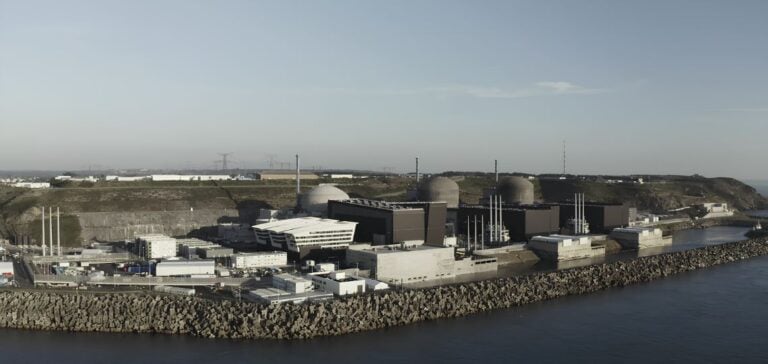After 20 years of technical, financial, and regulatory challenges, the EPR (European Pressurized Reactor) in Flamanville, Normandy, is finally set to begin operation. EDF has announced that the reactor will be connected to the electrical grid on Friday, December 20, 2024. This historic event marks a new phase for French nuclear energy, which hasn’t seen the commissioning of a new reactor since 1999, with the Civaux unit.
The Flamanville 3 reactor is a large-scale project: it is the fourth EPR in operation worldwide and the 57th reactor in the French nuclear fleet. With a capacity of 1,600 MW, it is the most powerful reactor in the country and will supply electricity to two million households. However, this technological achievement has been marked by major setbacks, including a 12-year delay from the original schedule and a final cost of €13.2 billion, nearly four times the initial estimate.
Testing, which began in September 2024, has allowed for a gradual power ramp-up. EDF plans additional adjustments through the summer of 2025 to finalize the testing phase. Once fully operational, the reactor will run at 100% capacity until its first maintenance shutdown, called “Full Inspection 1” (VC1).
From the outset, the Flamanville EPR has exemplified the complexity of major industrial projects. Launched in 2007, it faced several technical setbacks, including anomalies detected in the reactor vessel’s steel and welding defects in the primary circuit. These issues, reported by the Nuclear Safety Authority (ASN), caused significant delays.
The financial bill, initially estimated at €3.3 billion, skyrocketed to €13.2 billion, according to EDF. When factoring in financing costs and other unexpected expenses, the French Court of Auditors estimated the total cost at €19 billion.
An emblematic project for French nuclear energy
Flamanville 3 is more than just a reactor. It embodies a strategic revival of nuclear energy in France after a decade of criticism and crises. In 2022, a series of stress corrosion problems caused a historic drop in French nuclear output, forcing the country to import electricity for the first time in 42 years.
However, EDF has managed to turn the tide. In 2023, nuclear output rose by 15%, reaching 320.4 TWh, and projections for 2024 range between 358 and 364 TWh. The commissioning of Flamanville will further strengthen this momentum, enabling France to maintain its status as the European leader in nuclear power production.
A controversial technological model
The EPR is designed to provide enhanced safety and superior energy efficiency, but it has not escaped controversy. To date, only three other reactors of this type are operational: two in China (Taishan 1 and 2) and one in Finland (Olkiluoto 3). All have experienced significant delays and cost overruns, fueling debates about the economic viability of this technology.
In China, the two EPRs at Taishan, commissioned in 2018 and 2019 respectively, faced interruptions due to technical issues, including corrosion. The Finnish reactor, meanwhile, started with a 12-year delay after legal and financial disputes between the builder and the local operator.
A symbol of revival for France
Flamanville’s connection to the grid comes amid a redefinition of France’s energy policy. In February 2022, President Emmanuel Macron announced an ambitious plan to build six new EPR2 reactors, an optimized version of the EPR, with an option for eight more. This strategic choice aims to address the challenges of the energy transition while ensuring France’s energy sovereignty.
Although the Flamanville project was launched well before this revival, it symbolizes the desire to reinvest in nuclear power. This choice remains controversial. Proponents of nuclear energy highlight its advantages in reducing CO₂ emissions and ensuring stable output, while detractors emphasize the risks, high costs, and radioactive waste management.
Nuclear energy is also a geopolitical lever. Thanks to its surplus production, France exports large amounts of electricity to its European neighbors. In 2024, a historic net export record, estimated between 85 and 90 TWh, is expected to be achieved. These exports strengthen not only the French economy but also its influence in European energy debates.
The setbacks of the Flamanville EPR serve as a reminder of the challenges associated with major industrial projects. However, they also offer valuable lessons for the future, particularly in the design, management, and financing of future reactors.
A global perspective
Globally, EPR projects continue to develop, albeit cautiously. In addition to Flamanville, another reactor is under construction in the United Kingdom at the Hinkley Point site. Again, this project has faced significant cost overruns and delays.
The future of nuclear energy will largely depend on the ability to capitalize on technological innovations while controlling costs and timelines. For EDF, the Flamanville EPR represents a unique opportunity to demonstrate the viability of this technology.
Flamanville 3, despite its challenges, opens a new era for nuclear energy in France. This project illustrates both the complexities and the promises of a key sector for the energy transition. The connection of this reactor to the grid will mark a milestone not only for EDF but also for the entire European energy landscape.






















